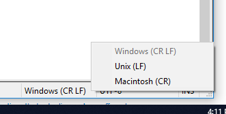I've seen answers to the questions, but those answers are not from a windows perspective from what I can tell.
Windows uses CR LF, Unix uses LF, Mac uses LF and classic mac uses something else. I don't have the brainpower to tell that somehow, if a file is using a different line ending than what I am typing, I get errors when trying to run the script/program which frankly, don't make much sense. After conversion, the script works just fine.
Is there anyway to preemptively check what line endings a file uses, on Windows?




0x0Dand0x0Arespectively. The pair of them (in that order) make up a Windows line end. – Exum